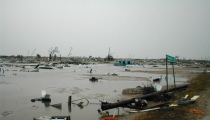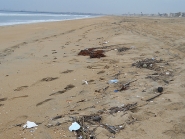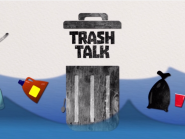To mitigate the impacts of debris resulting from acute marine debris incidents, the NOAA Marine Debris Program is facilitating response planning efforts in coastal states.
Emergency Response
Marine debris is an everyday problem, but natural disasters have the potential to make it worse. Hurricanes and tropical storms, tsunamis, floods, and landslides that impact U.S. coasts can be an overwhelming source of marine debris because high winds, storm surges, and heavy rains drag household products, lawn furniture, and even entire homes into the surrounding waters. In some cases, this debris ends up in shallow coastal waters, which could threaten navigation, natural resources, or human safety.
In 2012, Sandy inflicted severe damage to communities and coastal resources in the Mid-Atlantic and Northeast states, leaving a swath of destruction and large amounts of marine debris.
NOAA responds to marine debris from the 2011 tsunami in Japan with federal, state, and local partners.
NOAA led efforts to map and survey marine debris following Hurricanes Katrina and Rita.







